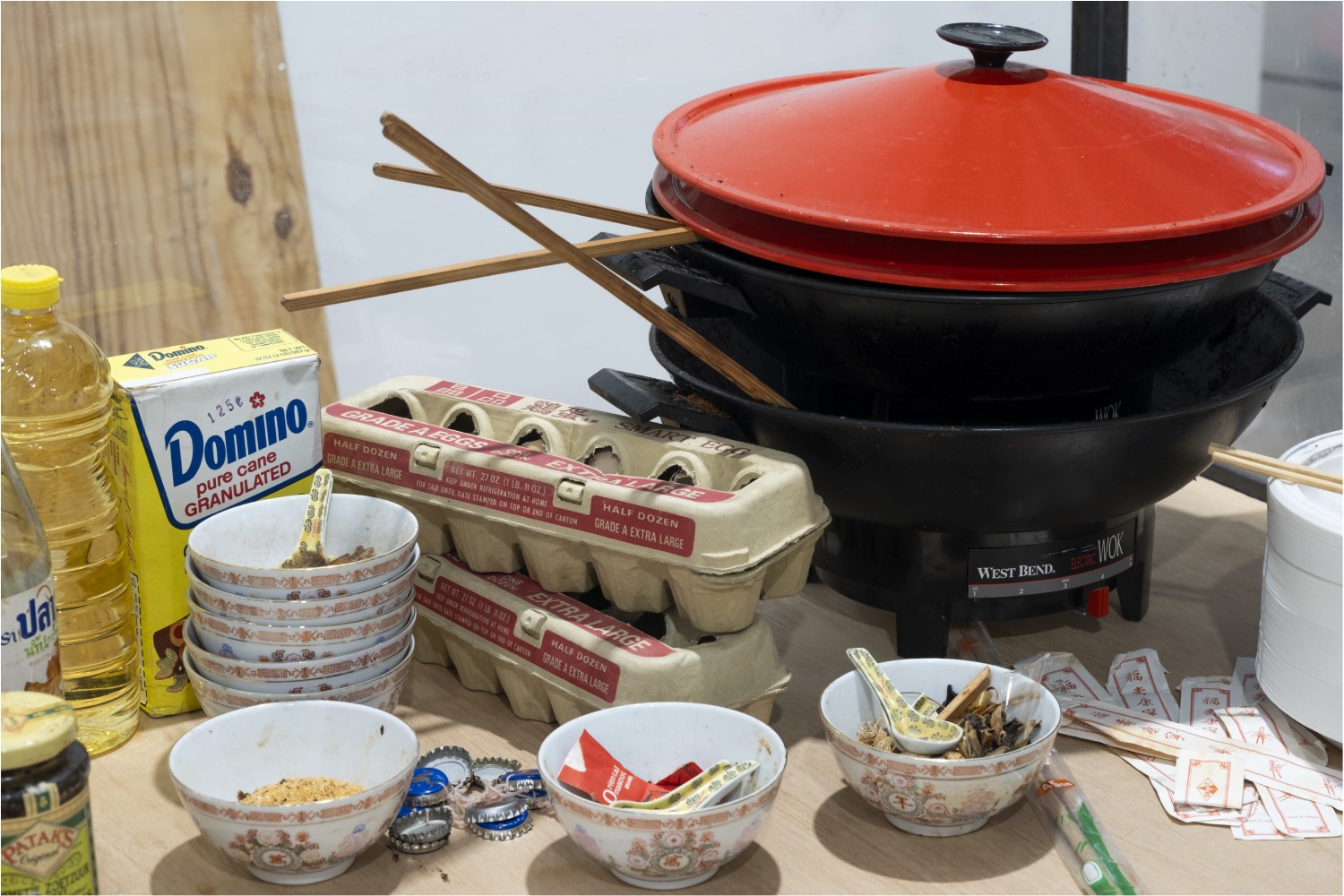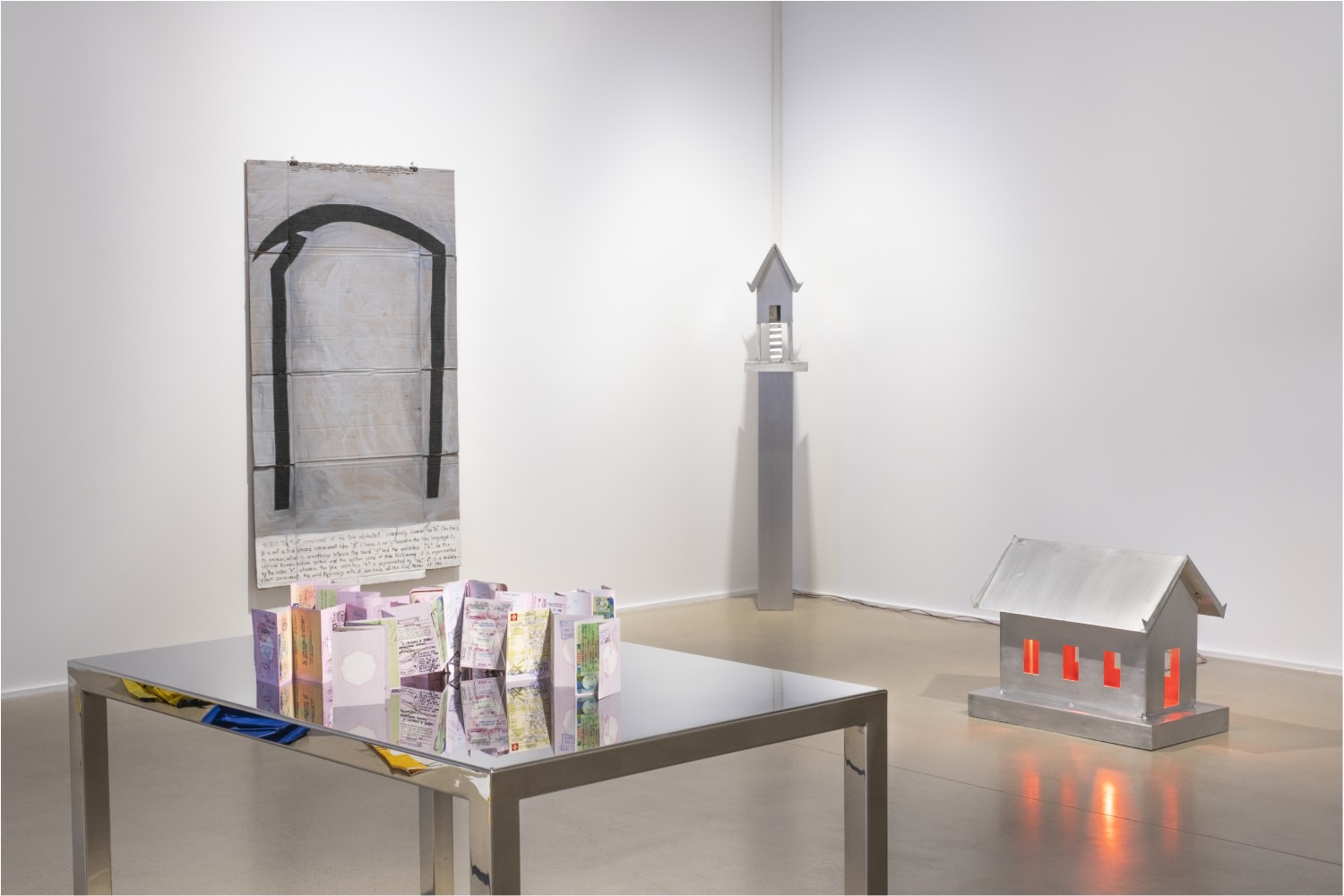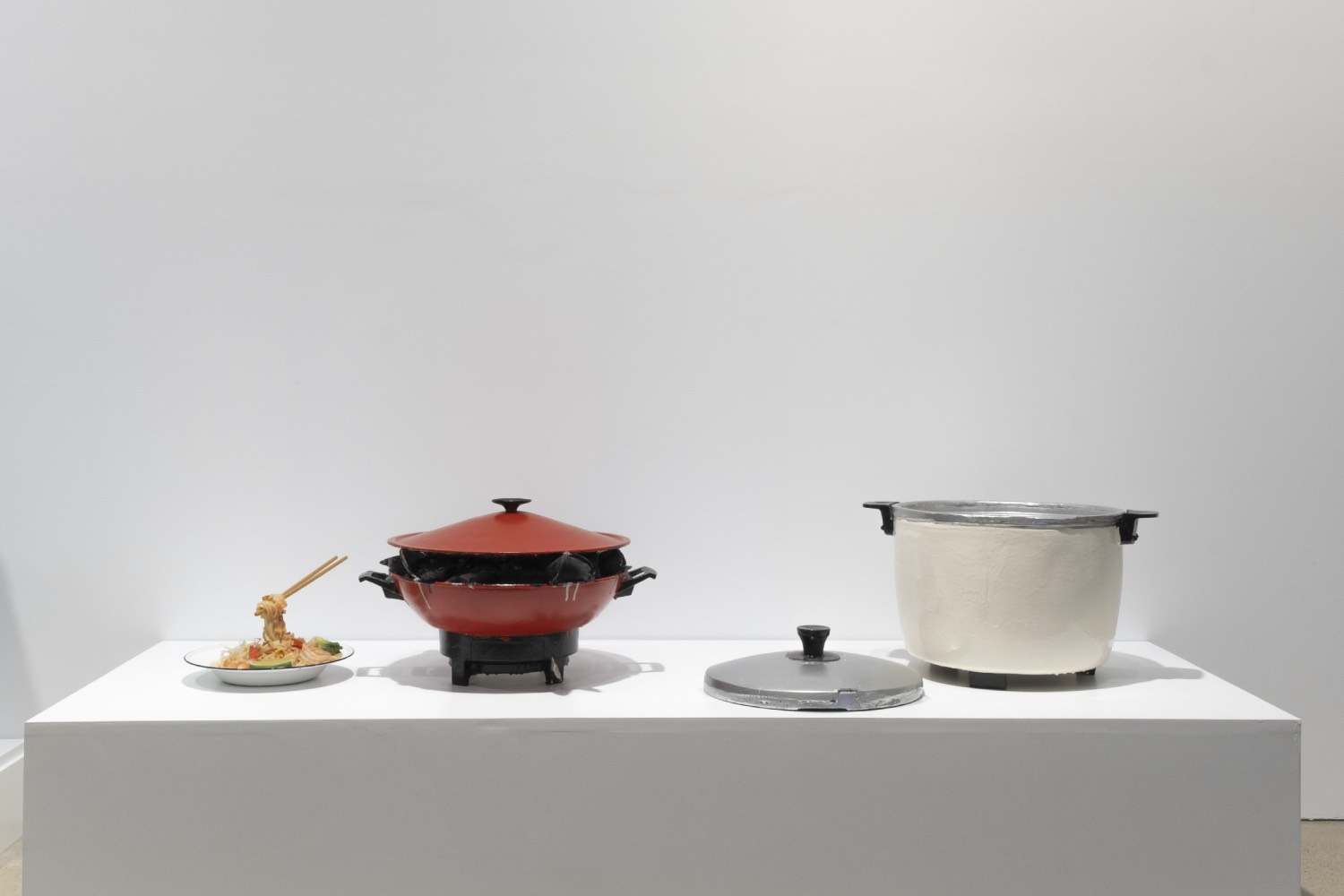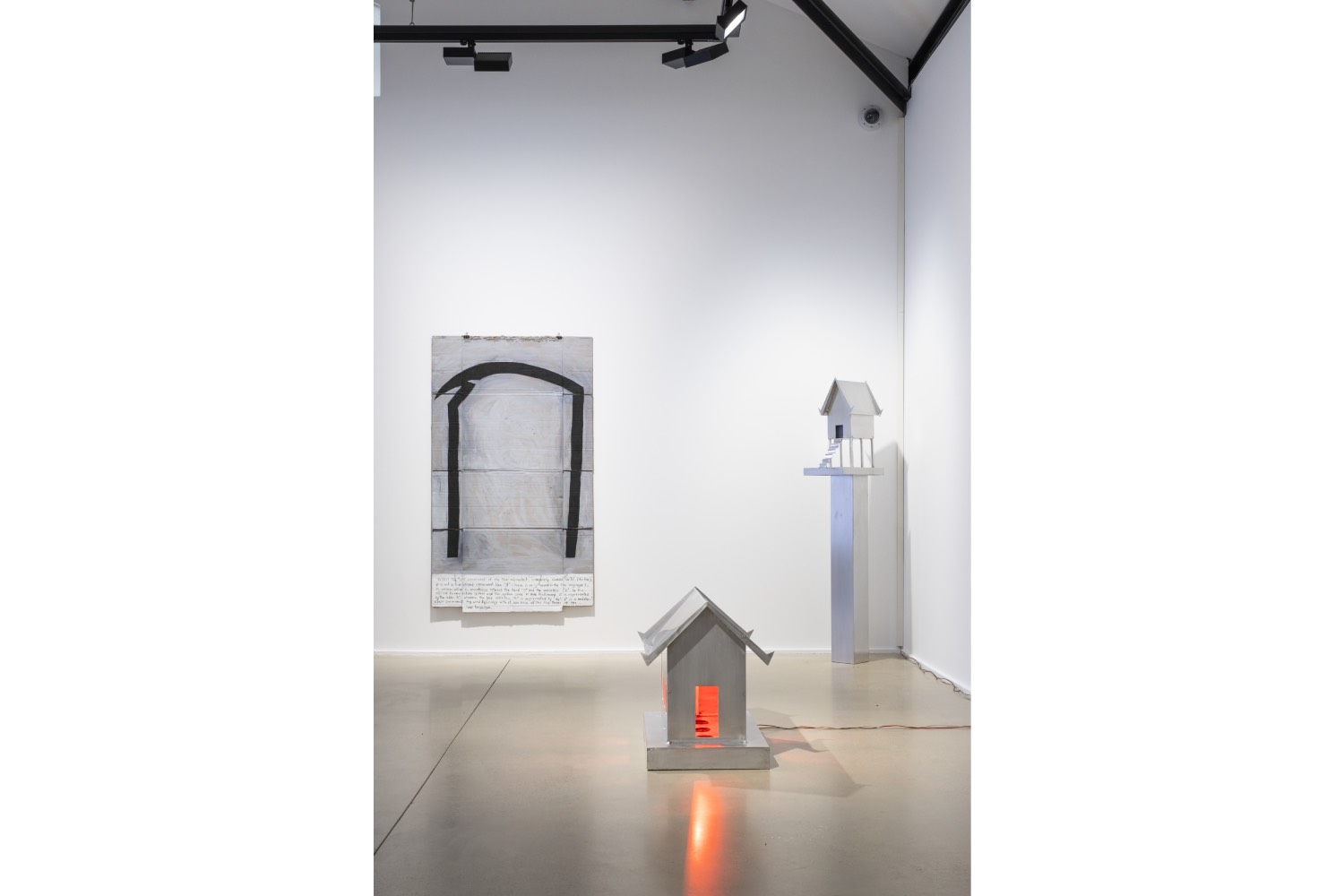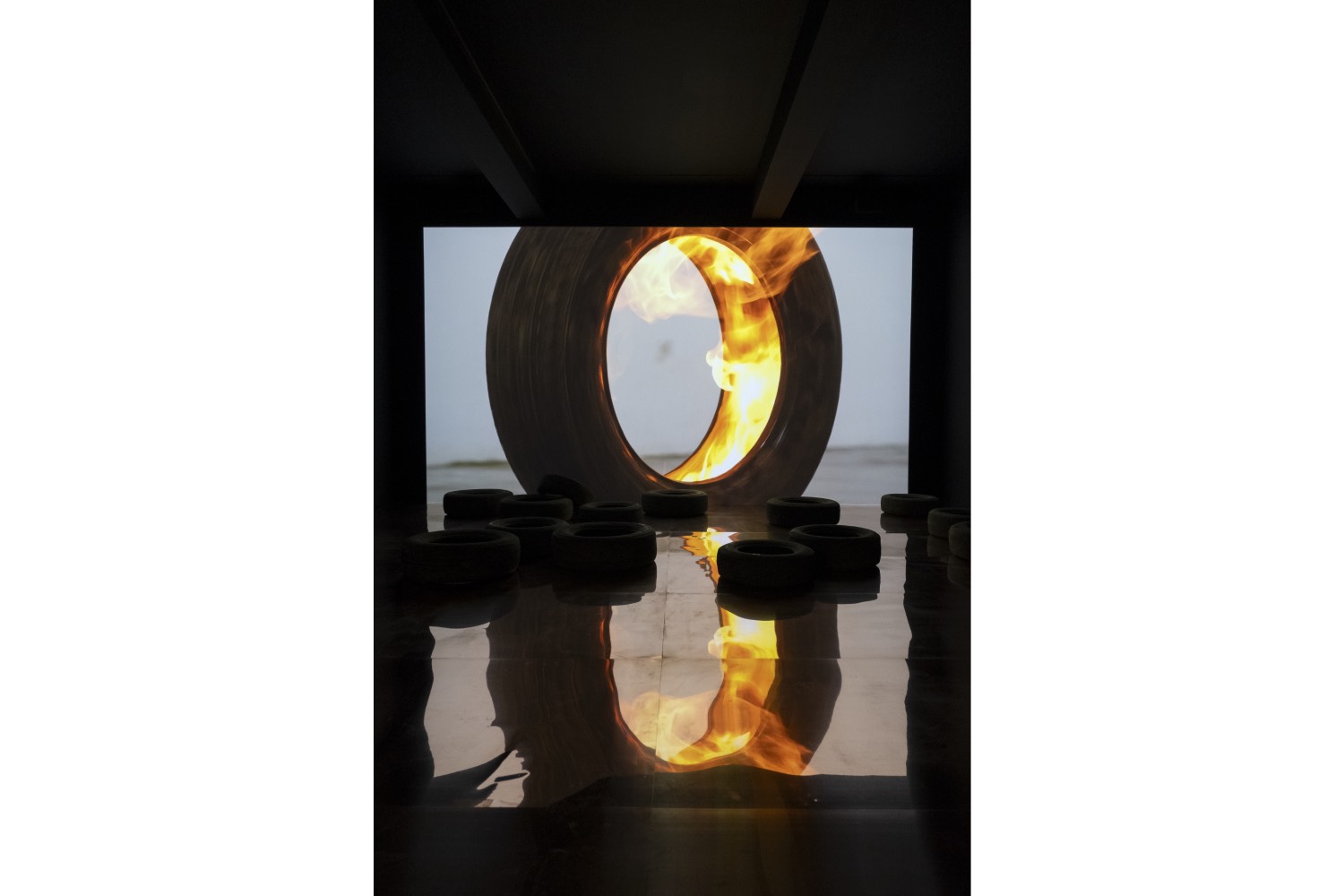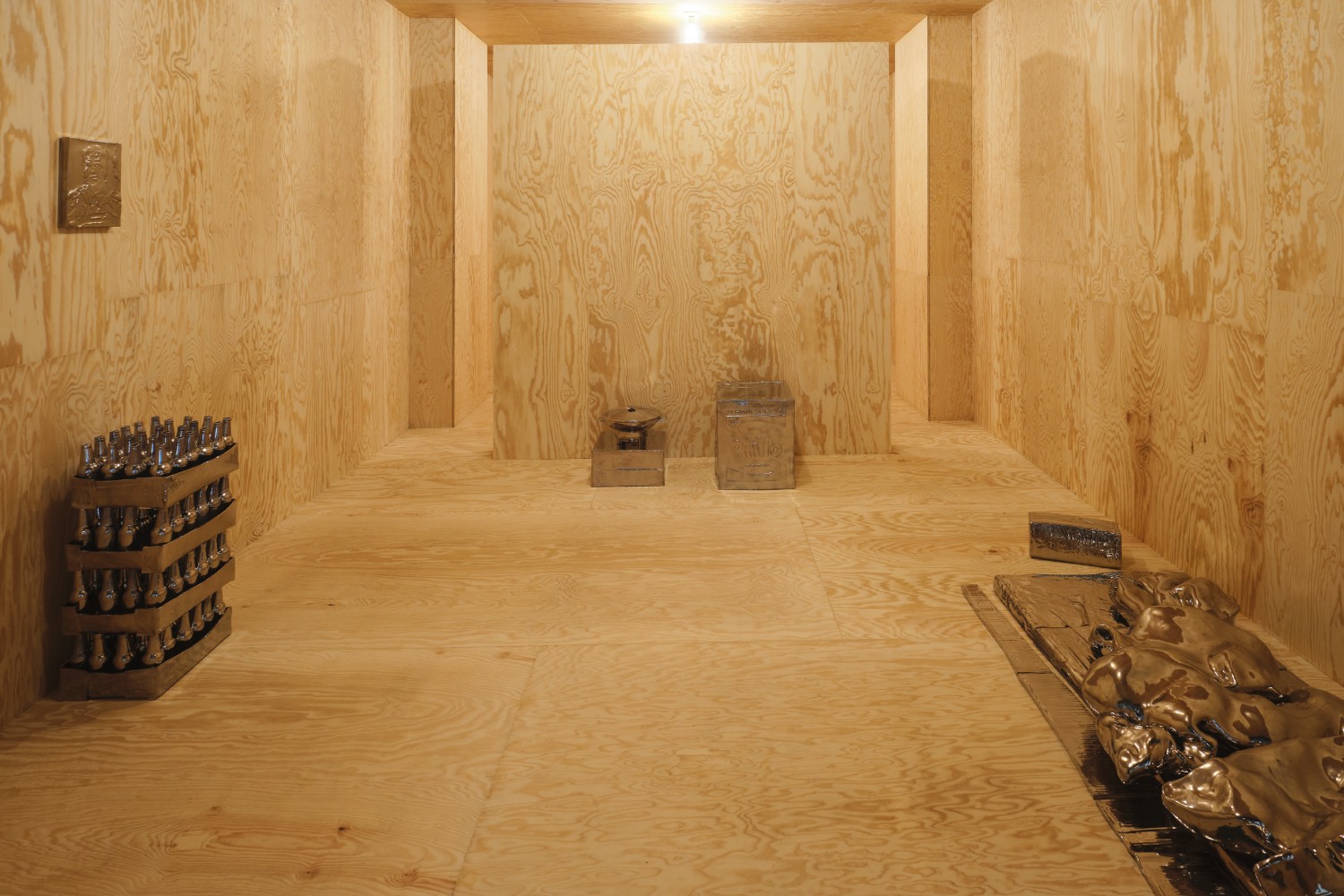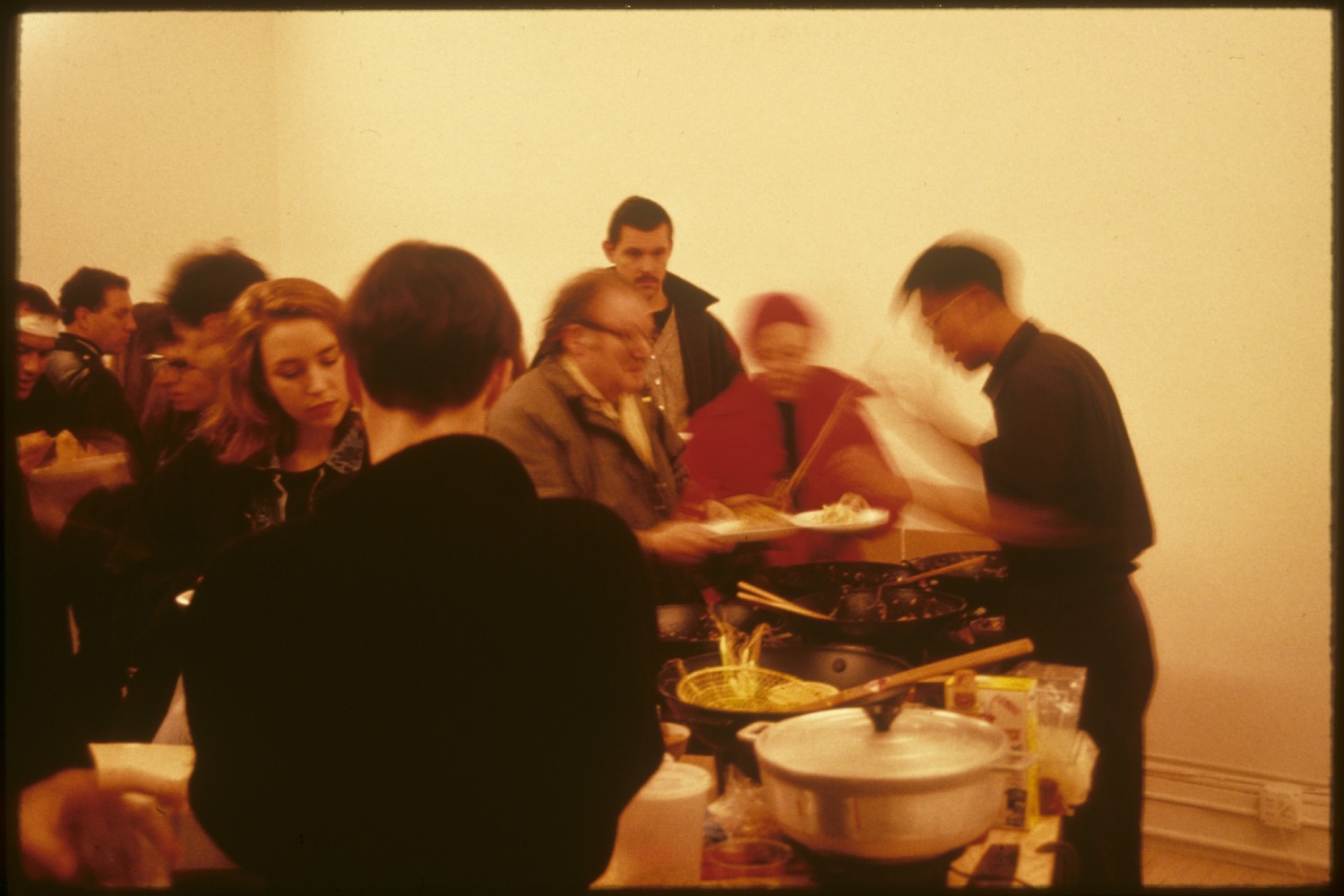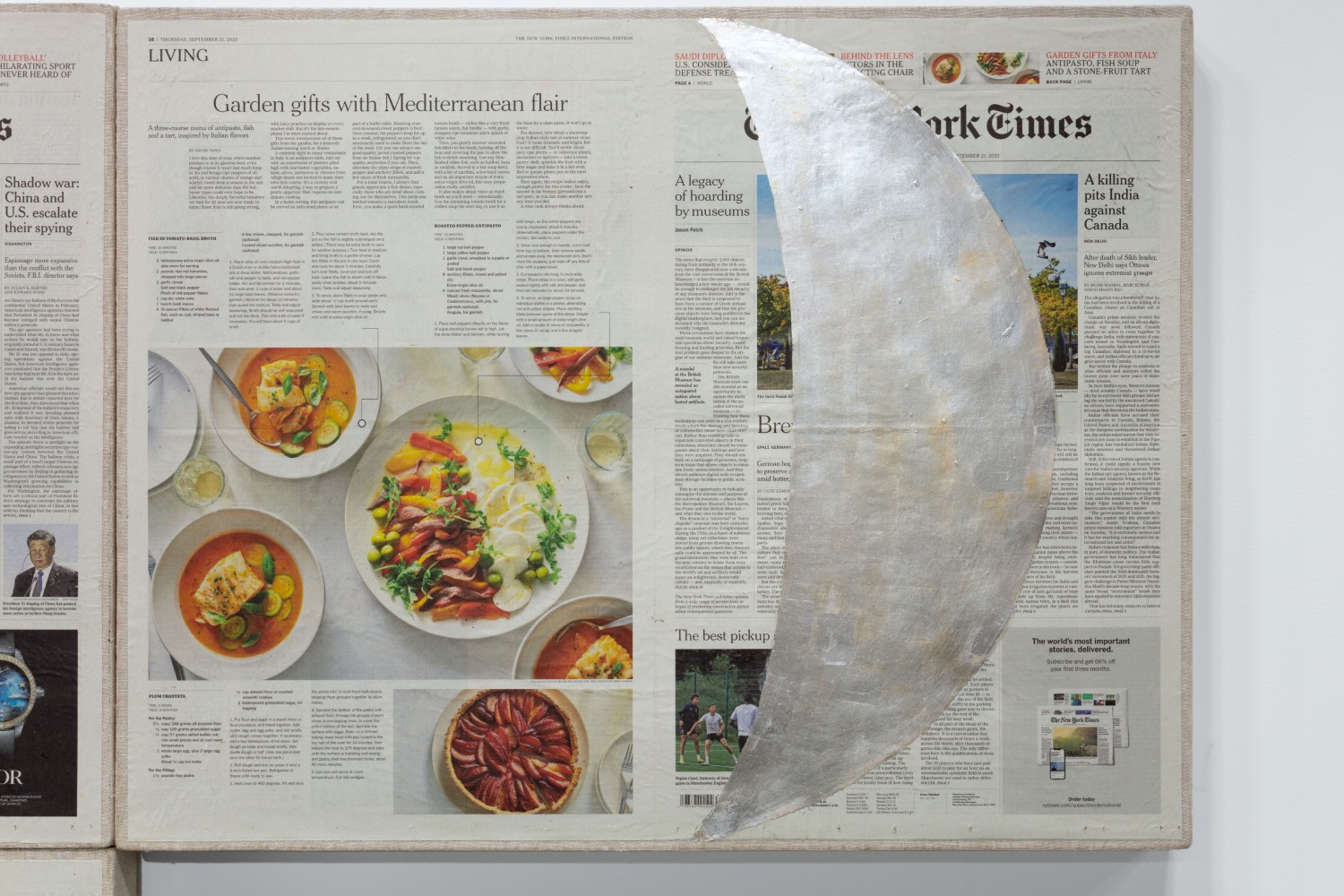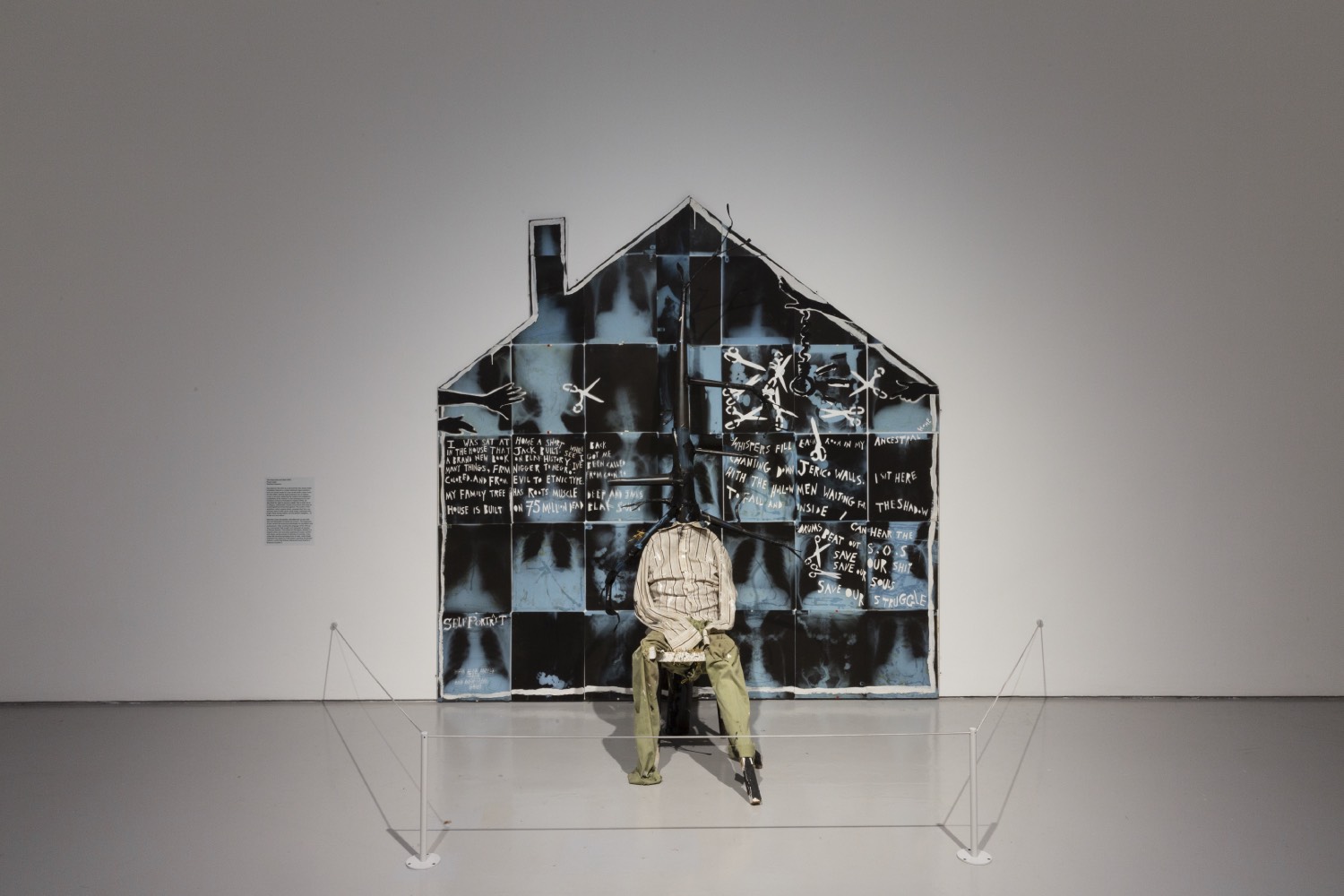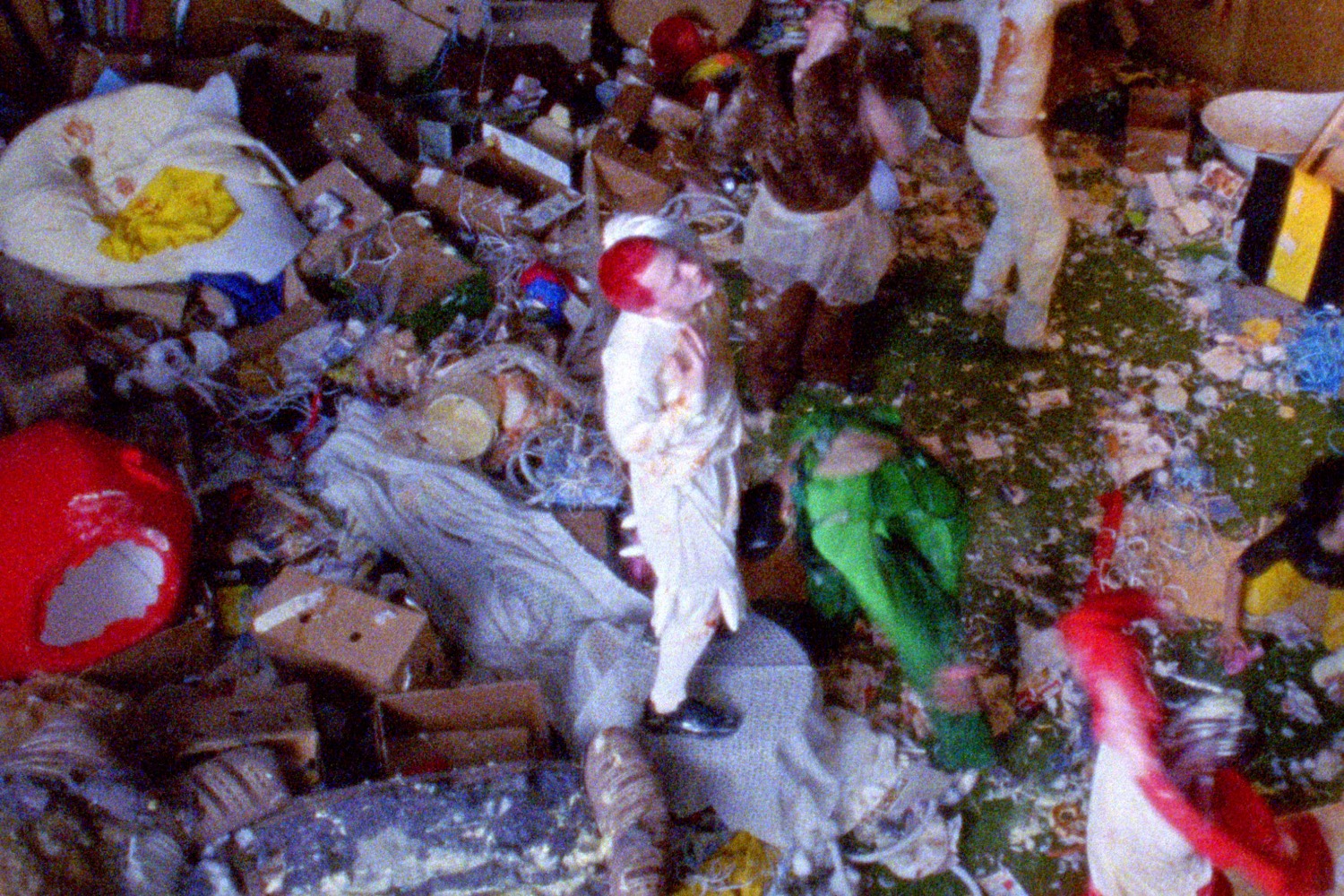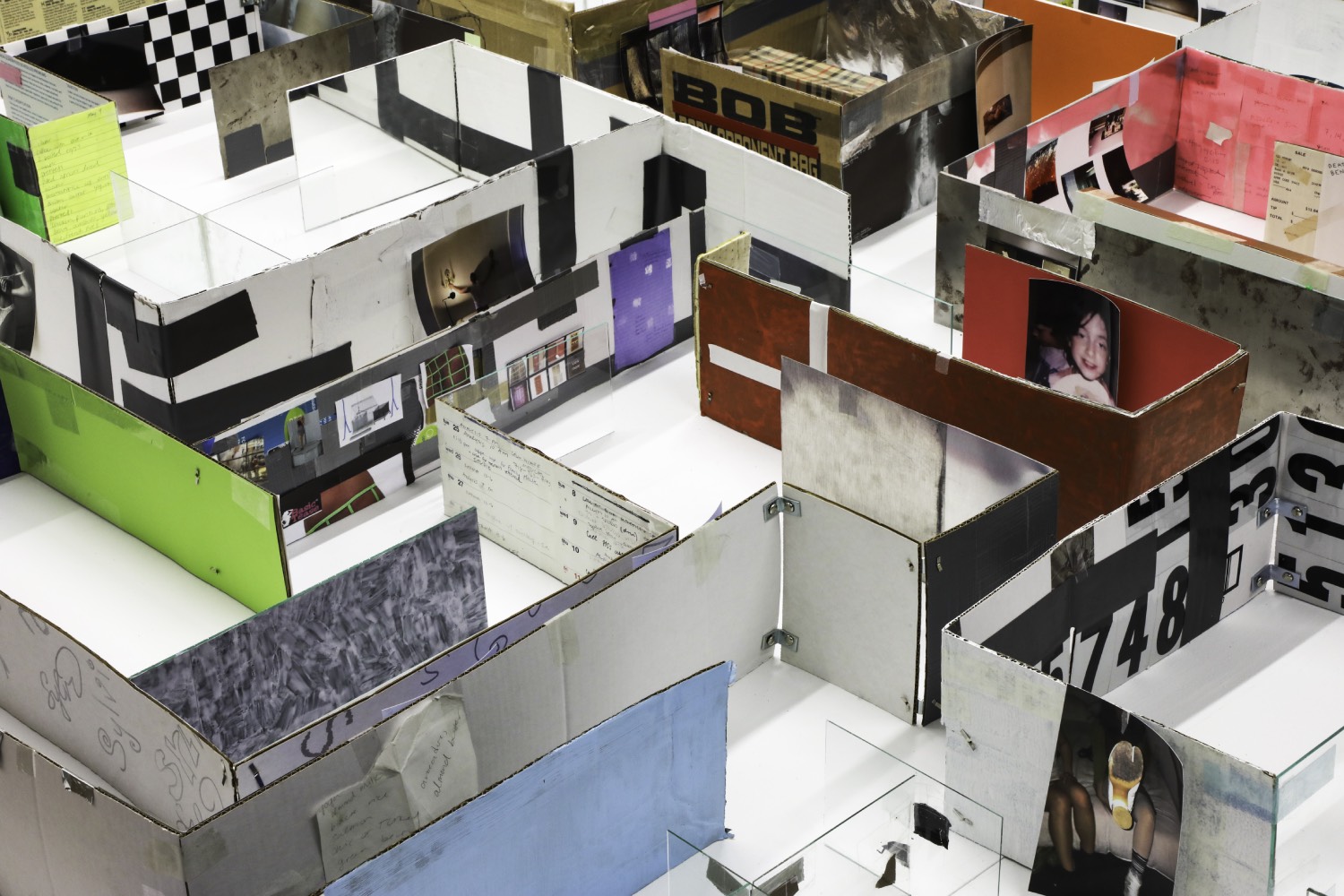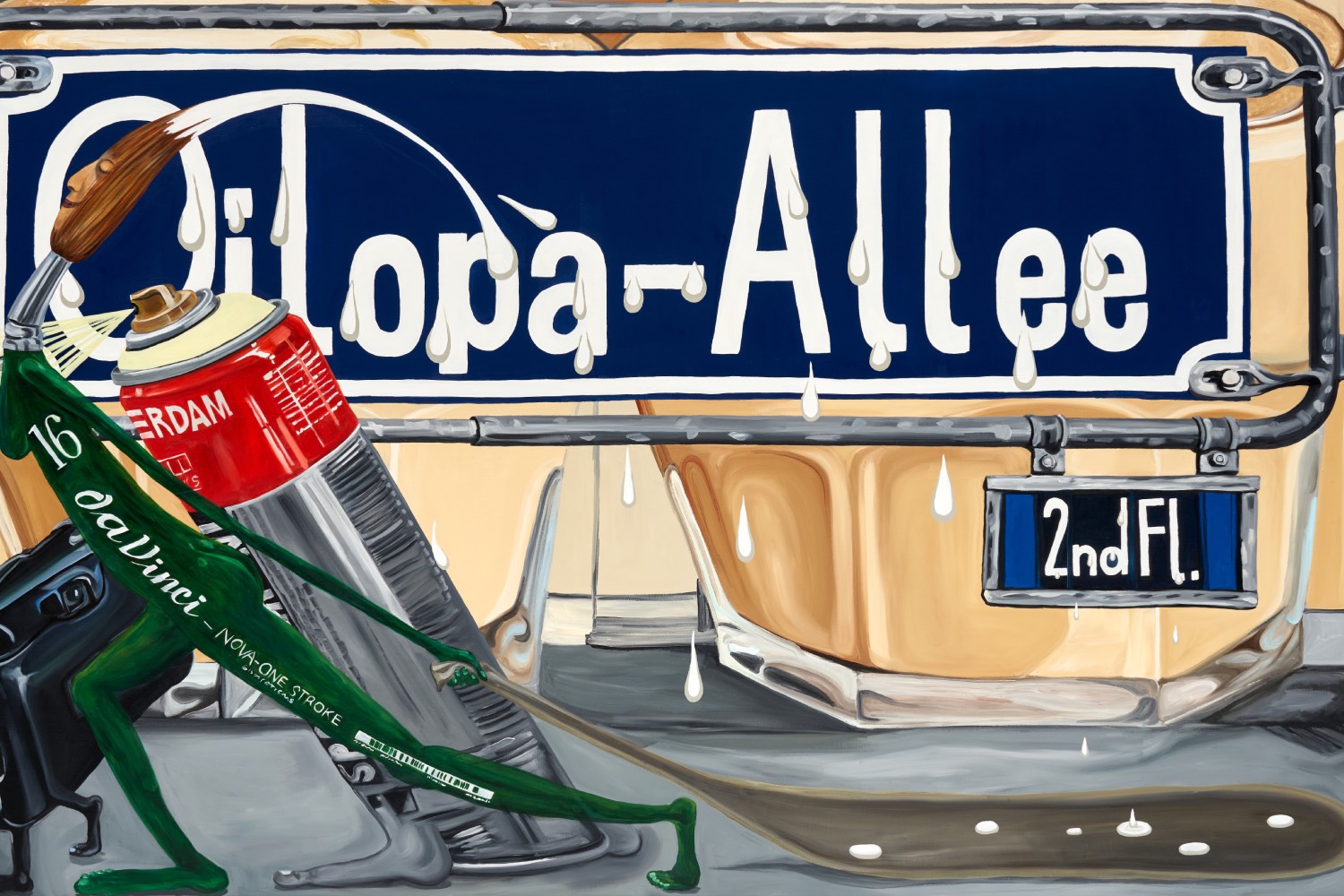I unfolded the letter and read the contents. The letter is a xeroxed copy.
The first line of the letter reads as follows: WITH LOVE ALL THINGS ARE POSSIBLE
On the morning of January 2, 1993, Rirkrit Tiravanija received an unexpected letter at his New York apartment. This letter, part of a chain, sparked his imagination: it contained a message of good luck he had to share. He meticulously described its arrival, appearance, and contents, then created nineteen copies, which he later sent with the original to twenty prominent New York gallery owners — Helen Weiner, Paula Cooper, and Barbara Gladstone, among others. untitled 1993 (chain letter) (1993) is exhibited for the very first time in Tiravanija’s retrospective “A LOT OF PEOPLE,” currently on view at LUMA Arles, and organized in collaboration with MoMA PS1, New York. Spanning four decades, the exhibition showcases over a hundred pieces from his early artistic experiments in the 1980s to recent works, including The Shop (2023), a politically charged piece recreating a Hong 106 107 Kong umbrella store, referencing the 2014 Umbrella Movement protests against the proposed reform of the country’s electoral system with elements gathered from sci-fi literature, like The Three-Body Trilogy by Chinese author Liu Cixin. The chain letter epitomizes Tiravanija’s stunning ability to bring people together.
As explained by the artist himself, the show’s title underscores the importance of community and interaction, which are palpable throughout the participatory installations. Visitors gather around pieces like untitled 1993 (turkish coffee) (1993), featuring a coffee counter conceived of books, art catalogues, newspapers, and boxes, where performers prepare Turkish coffee for them to sip while enjoying the exhibition or exploring the eclectic pile of printed materials. Tiravanija’s work often focuses on minor narratives within society, shifting the focus from himself to the broader picture. His approach considers every skill, even cooking, as a potential art form, which is frequently used to express political messages, document travels, and create infinite connections. As the title suggests, people are central to activating and imbuing the artworks with meaning.
“It’s about being with a lot of people,” Tiravanija tells Hans Ulrich Obrist. In their conversation (their 15th conversation!), they discuss Tiravanija’s journey into art, reflecting on his early experience and influences and his shift towards integrating everyday life and Buddhist practices into his work, the significance of rituals of dissemination in art, and the importance of allowing the audience to interact with his works. Touching on Tiravanija’s varied practices – from drawing, painting, and sculpture to film and photography – the conversation highlights how each contributes to his overarching philosophy of art as an extension of life.
Hans Ulrich Obrist How did contemporary art get to Thailand?
Rirkrit Tiravanija I would say it happened in the late 1940s, early 1950s. The person who started modern art in Thailand was an Italian man, who came to work for the king, who came to do sculpture in the palace. His name is Silpa Bhirasri; and his real name was Corrado Feroci. I wrote about this for the Thailand Biennale, I was trying to contextualize it. Well, he fell in love with a Thai lady and they got married, and then he was commissioned to start the art school. All the early Thai modernists learned about modern art through him, but then, in the 1970s, there was a move toward a more Thai identity, almost nationalistic, back to Buddhist imagery. We call it contemporary Buddhist art, but, to me, it’s very surrealist, populated by creatures and angels, but traditionally done in a sense. Anyway, they all really hated me. And so I was saying, the artist who built this White Temple is a very strong, important artist in Chiang Rai, where we did the Biennale. I’m just telling a story. So, because, of course, he is a very prominent artist, he wanted to do the Biennale. And with that, he basically suggested that they ask me to join as a kind of artistic director.
HUO: How did you get to art in the first place?
RT: I actually came to art without knowing anything about art at all. I took up photography in high school — I would take photos for the newspaper and for the yearbook. It was the mid 1970s and my friends and I were all interested in photography, we were looking at Life. My father was a diplomat, and I was very resistant toward the bureaucracy of working for the government, so I decided, “Oh, I should just become a photojournalist.” Because, of course, I grew up traveling, I always had this instinct to move. And also, I didn’t want to work for someone; I wanted to be free. So, I went to Canada because my father was stationed there. In Ottawa, I enrolled in the history department to start journalism; then I took art history, because I wanted to do photography history. And that’s when I saw art, flashing on the screen every Monday night: White on White (1918) by Malevich one day, Duchamp’s Fountain (1917) the following week. I thought, “Okay, I’ve got to go find out what this is all about.”
HUO: So it’s like a portal opened in a way?
RT: Yes. The next day I went to the council because I wanted to understand what it meant studying art. I was waiting in this waiting room, which was more of a library, and on one shelf there was this white book. I pulled it out, and it said, “Ontario College of Art.” I just took down the address and then I left. I never had a meeting. I made a portfolio, I sent it, and then I got in.
HUO: And that’s when you made the first work, untitled 1982 (buddhist temple), 1982?
RT: Well, in your first year, you had to start with basics. Then, the following year, I was finally in the department that I wanted to be in: experimental art, art from Abstract Expressionism onward. The fine art department used to go to Florence to study and practice their art; we went to New York, and that’s where I made that first sculpture. I was good at making things with my hands. I started making models, because that’s how I think, in a way. So, the early works had lots of architectural elements. At that time, it was 1980 or 1981, everyone was looking at Dennis Oppenheim and Alice Aycock and Vito Acconci, who were all very spatial and architectural.
HUO: When we were first introduced by Lynn Gumpert in New York around 1990, or 1991 maybe, I remember you had not really been back to Thailand, right?
RT: No. I went back briefly in 1987.
HUO: And what was the first show you had in Thailand?
RT: I think the first time my work was shown there, it was probably at Navin Taxi Gallery, Bangkok. It must have been 1995 or 1996.
HUO: Then, in 1996, there was my show “Do It” at Bangkok University, where you contributed a recipe which was presented alongside Bangkok-based artists such as Surasi Kusolwong and Chitti Kasemkitvatana. I remember that already in our first meeting in New York we talked about recipes. When did that interest begin?
RT: When I was in school in Toronto, John Cage came there and that was quite an experience. We did performances with him at the University of Toronto. Then I also met Roberto Feleo. We went out to some countryside place and sat in a barn and listened to him talk about everything. Those were formative years, but I think that interest was already there. I must say that the practice of cooks is very close to the practice of Buddhism. It’s more about life, about thinking about life and the practice of living. I think that was a very natural way to go. At that point, I had made a lot of sculptures that don’t exist anymore, and a Canadian artist I really respected told me, “You should stop making art.” At first I thought he was right, but then I realized it was not so much to stop making art, but to rethink what making is. For me, it was more about methodology or thinking. When I first made a work that involved cooking, it came down to what is the most basic thing that comes naturally to you. I asked myself what was important to me that I could do that would convey what I was thinking then, which was also what the Fluxus movement was trying to do. I wanted to shift away from the object and toward life; but also away from that Fluxus experience because I could see their failure: once everyone was gone, the focus returns to the object that was left behind. It’s still a relic.
HUO: Somehow it was a one-way road, it was stuck. But it’s interesting, in untitled 1982 (buddhist temple), 1982, there is also a ritual component. We now live in a time when there is a lack of ritual. The Swiss-Korean and Berlin-based philosopher Byung-Chul Han wrote a whole book about our society being bereft of rituals and how we need to reintroduce them. I think the idea of Buddhist rituals, or rituals in general, remained in your practice ever since the very beginning.
RT: The idea of ritual goes deeper into the idea of karma. We do merits to reduce our bad karma, and we do merits to enhance our good karma. It’s more about this rather than rituals, because I feel like I’m a weird orthodox practitioner, which is to say I don’t do unnecessary things. I would just say that rituals are in every day and in every part of your nature.
HUO: I noticed there is an interesting gap. We are doing this conversation on the occasion of your retrospective. “A LOT OF PEOPLE” was at MoMA PS1, New York, and it’s now in a very different reincarnation at LUMA Arles: walking thought the show, looking through the catalogue, one can notice a five-year break after your first works in 1981 and 1982. What happened during those five years?
RT: I went from undergrad to grad school, which was a time when I was rethinking how not to do anything in that sense, and I had a lot of questions about authorship and institutional framing of art. It was a moment when I realized that all these things in museums have been collected and taken out of context. And without that context, you really don’t understand it other than its objectness or its craftsmanship, which don’t necessarily inform you about where they came from. In a sense, I was trying to retrieve that place where they came from, or that moment, or that usage, or that life around it. I was in Chicago at that time and I started to question the objects in the museums of the city, which I think many people were doing anyway. My last work in grad school was called untitled 1987 (text in red and black), 1987. It was this little light on a little text on the wall that said, “WE DEMAND THE RETURN OF OUR CULTURAL ARTIFACTS IN THE MUSEUM OF THE ART INSTITUTE OF CHICAGO. OTHERWISE WE WILL BLOW IT UP.”
HUO: It’s really interesting to see the connection to the restitution debate forty years later.
RT: Immediately after I made that piece, there were Thai people protesting at the museum to return a particular stone lintel piece from a famous temple that had been taken away during the Vietnam War. A lot of people attribute that protest to that fact that I did that note, but I think it was just coincidental.
HUO: Around the same time I met you, I also met Felix Gonzalez-Torres for the first time. He wasn’t interested in these 1980s artists fighting for wall space, and basically decided to do something else. He was obviously talking a lot about this idea of the artwork being disseminated, so that it could happen in many households. This is something that has always interested me because I grew up in a household without art. The only way I had to experience art was because my mother would buy this Emma Kunz medicine, and on the pack there was an abstract spiritual drawing Kunz realized with a pendulum. I always felt like we need to bring art to every household. So, Felix was a great inspiration. I was wondering to what extent, at that time, was he important for you? Or who was important for you and your practice?
RT: I’ve mentioned Felix in the past. And I’ve mentioned Carl Andre, too, and this idea of a boundary: there’s a whole thing about how one walks over Carl Andre, and in the middle of it you realize you’re standing on a sculpture, but, of course, nobody tells you not to because of course you’re supposed to walk over that sculpture. With Felix, this idea of dissemination is the idea that the audience can pick up the art and go. And the first person to pick it up must be someone without boundaries, because we normally don’t touch art. For me, the idea of letting things disseminate is also about letting things go and about giving people the choice to step over a line. That decision to step over that line is really important to me.
HUO: I was super fascinated by Fluxus, and I even went to visit Alison Knowles and Yoko Ono. They were a huge inspiration, but at the same time, I also felt there was some kind of danger of ending up with a relic. In Felix’s work, there was a very precise form; his instructions led to a very precise form, and that form would ultimately be replenished in some way.
RT: It’s something we all have, so the value is not high. And that’s of course very Fluxus, to make the value not in the object but in the action.
HUO: In “A LOT OF PEOPLE” we can see the cooking ethos appear at the very end of the 1980s. What was the cooking epiphany? Do you remember the day when it happened?
RT: untitled 1989 ( ), 1989, a black-and-white image, was really the first cooking piece. I would say that the work is always coming from the life. The piece was in a group exhibition that Robert Longo had put together at SoHo Gallery on West Broadway. As I was walking down West Broadway to go look at the space, I realized this would be my first work exhibited in New York, and I started wondering what I should do. It just came to me, like, “Oh, I should just cook.” It wasn’t obviously just about cooking, because I always had friends over for dinner and cooking was always a central part of my natural life environment. It was also a question of the object and how to reanimate it. So, I made a pot of curry and made the kitchen visible so that the process of how that thing was being made was displayed. This is how it all started: when the audience came, at first I realized, “Oh, that was a mistake,” and then, “Now I have to do something else after this.”
HUO: And then the chain reaction never stopped.
RT: Well, it’s still a process to always be aware of all the things and your intentions, and then how that intention is maybe misguided sometimes, and how you need to adjust and find another solution or find a way to get to the answer.
HUO:Another thing that you started working with in the early 1990s is this idea of the sentences, when you do the paintings, something you never stopped doing. Can you talk about how that came about and what were these slogans in the 1990s?
RT: As you were talking about Felix, I was also thinking about Group Material, Jenny Holzer, and Barbara Kruger — artists that use language provocatively. It’s also rooted in my experience living in northern Thailand, where you can drive up a mountain, a really difficult road, and then suddenly in the middle of nowhere on the top of the tallest tree is a nailed plank of wood that says, “Jesus will save you.” It’s like a sudden spark that happens with the whole context and environment.
HUO: Can you talk a bit about the slogans for The Arrival, 1990? They’re not really slogans, but they’re not haikus either.
RT: I don’t even know how I got to do that Times Square message board; it wasn’t like I proposed it. They asked me to do it. Those were just quotes, but they were also open quotes of an idea. An idea that was also trying to deal with the context, with the tools, and also with the place, Times Square. I still think “The cat licking a bowl of milk” was the best quote. It was a message used during the Vietnam War and by Indigenous people in the mountains, so, in a way, it’s all postcolonial markers.
HUO: One thing about these quotes is of course the question of appropriation. There was a lot of appropriation in the 1980s. Elaine Sturtevant never liked that term. She talked about repetition. It’s not exactly appropriation, because you insert yourself into it and you also somehow change it. It’s interesting how you feel about this notion.
RT: It’s more about the methodology, in the sense that when I make a space, I usually use spaces that I know will work and it doesn’t matter if it’s my apartment or the Schindler House. It’s about understanding how that particular frame works bringing it back. It’s about rethinking it. It’s about being reminded that we should rethink that or look back again at that. Because we’re still in the same loop, and why is it that we have not gotten to a better place?
HUO:So why haven’t we improved? Or why haven’t the governments improved?
RT: Well, maybe we’ve improved in the wrong places and we are regressing in the places we should have improved. I think maybe it’s just simply human nature. You and I worked together on “Utopia Station” (2002) — have you ever wondered why we’re not in utopia yet? Why are we not able to see it together? I think that’s partly because we’re afraid of ourselves, we’re afraid of being capable of doing better than what we think we are.
HUO: One thing that is also striking in “A LOT OF PEOPLE” is the revelation of you making drawings. I think nobody really knew the extent to which you draw! We have untitled 1990 (pad thai series), 1990, an early ink on vellum from the “Pad Thai” series, but there are even watercolors. Can you talk a little bit about your drawing practice and your watercolors?
RT: It’s like I have a photography practice, a film practice, a watercolor practice, and a painting practice.
HUO:Against all odds. And so you have a Brinkmann burner, untitled 1993 (brinkmann burner), 1993, you have a cartoon of Pathmark juice, untitled 1993 (pathmark orange juice), 1993, and there’s also a pair of orange shoes.
RT: Everyday things.
HUO: Did you continue to do that?
RT: Slowly. I even have a series. I don’t even know where they are anymore. I do it when I need to do it.
HUO: What about your photography practice? Tell me about that.
RT: Well, as I told you, I wanted to be a photojournalist. So of course there’s always been a photographic practice lurking in the shadows! I once took a trip to Marfa with some young students from Thailand, but we didn’t have a place to stay. So, they invited us to stay in Marfa’s compound itself, and then we took the students on a tour the next day. They walked through hundreds of Donald Judd pieces, hundreds, and then they were just looking. In the bookshop, they saw this Donald Judd catalogue and they said, “Oh, Donald Judd.” They didn’t understand the actual work they saw; they only understood it as photography. I think that was when the world started to live through photography. During that same trip, we went to the Grand Canyon, we went to Turrell’s volcano, we tried to go to the Spiral Jetty. But at the Grand Canyon, everyone was standing there looking at the beautiful, panoramic view, and they all had cameras up to their face, taking hundreds and hundreds of photographs at that point. That’s when I realized, “Okay, my photojournalism practice ends here.” I stopped taking pictures because everyone was taking a picture. I think it’s important also to say that we don’t look anymore. We need to slow down the gaze because we are just scrolling quickly through the world with our eyes. I think that slowness gives us a lot of reading, a lot of imagination, a lot of time with the self.
HUO: We still have pre-internet brains, even if they’re slowly fading. So, photography stopped that day in the Grand Canyon, but film didn’t. Can you talk about film in your practice? Because I think film plays a really central role in the retrospective.
RT: If you look at untitled 2008 (john giorno reads), 2008, you’re very well aware of time. John is standing there, in front of the camera, reading for eight hours straight. And you need to understand that when the screen goes black, we were changing the reel and then he kept going. It was basically done in one take. For me, film is a lot about the running time. It’s a duration, which is very different from a Pad Thai duration. The Pad Thai comes and goes, films can keep running, it can be a loop.
HUO: But film is also portraiture. Looking at your films, one is aware that you’re somehow making portraiture with film.
RT:You’re right. It’s portraiture even when it’s just a landscape, it’s the portrait of a space. I would say portraiture is looking close into somebody or someone we know, or someone we don’t know. But it’s also a lot of people, it’s about being with a lot of people.
HUO:“A LOT OF PEOPLE” is also the title of the show. How did it come about?
RT: I think it was between Gavin Brown, Rochelle Steiner, and I. At one point, we were doing different shows and we realized we had all these materials listed for the artworks, but the most important part of the work isn’t in all those things, but in the people.
HUO: Now let’s talk about painting. The most famous painting you did is untitled 2003 (less oil more courage), 2003.
RT: Yes, you know this story very well, because I made that painting while we were doing “Utopia Station.” One day, walking back to my apartment, I ran into Francesco Bonami and Daniel Birnbaum. They were having lunch, so I sat down and joined them just to have a drink, and they told me, “Well, we just realized we don’t have any of your works in the show.” They were doing this show in the Italian Pavilion and I had this idea for a painting, but I told Francesco that he should’ve made it instead. I really liked the idea of letting the curator make the work. He agreed without any resistance and, a week later, we all gathered at Francesco’s house for lunch, and he calls me to the side and says, “Come and look at the painting.” I went and I looked at it, and I was a bit disappointed because it wasn’t exactly what I thought it would be. The interesting thing about that is that that painting only exists in the Biennale catalogue. I don’t know if Francesco still has it. So, I left that lunch and I basically asked my then assistant, Francesca Grazi, to go to the stationery store and pick up some canvas and some paint and I made the work. Literally, I took it to the Giardini basically one hour before the exhibition opened, and they hung it on the wall. I knew that it would be a little nugget that everybody would want to chew on. Immediately after the show opened, I ran into some big collectors and they were very enthusiastic about the painting.
HUO:And then you started to paint more, in a way. What’s the role of painting in your practice? At the beginning, it was mostly texts, but you started the “Guston” series, and that was more figurative painting. It’s also painting on newspaper.
RT: Well, I was spending a period of time in Berlin, and my breaks were dedicated to reading the newspaper and watching the Tour de France, and that’s where the images of demonstrations came from. Of course, I would accumulate piles of newspaper as I’m reading it every day. And this is when Paul Thek comes into the picture: he was using newspaper because that was what he had, material-wise, so I was very much inspired by that idea. But again, the texts were inspired by that road-sign-in-the-middle-of-nowhere story I was telling you about earlier. This is how I approached those paintings. Even if, actually, texts first appeared on T-shirts I did with a group of young artists that I was working with in Bangkok. We would print the T-shirts and we would sell them in the market downstairs from where the office was. It was a way of putting words out into the world, and often people like to buy things with texts on them, as if they were decoration, but then not realizing exactly what the text was saying. The very first text on newspaper I did was for “Looking at Words,” a group show at Andrea Rosen Gallery, New York, in 2005. It was actually made as a wallpaper.
HUO: But then with your Philip Guston work, something else happened?
RT: Guston was one of those artists who always seemed significant for me, particularly regarding the practice. Then Donald Trump comes along with all his hateful and divisive rhetoric. This pointed me towards Guston, who was perhaps misunderstood in some ways. Even in the recent past, understanding Guston’s work as a critique has been challenging. For me, there were elements in Guston’s work that resonated deeply with the situation that we were facing under Donald Trump’s administration, especially considering Guston’s amazing Nixon work. Trump’s actions, such as building the wall and denying entry to people from Arab countries, as well as the movement of lawyers trying to help people cross the border, inspired me to raise money to support the cause.
HUO: Basically, what you did in this series is not appropriation because you changed and recombined the paintings.
RT: Definitely, I used some elements to readdress the idea with the content or the situation that was at the moment.
HUO: Let’s talk about poetry. Now, your work in poetry is smaller, but it exists. I remember you and I even created a poem together dedicated to Jackson Mac Low on a rowboat. What’s the connection you have to poetry?
RT: I’ve spent more time in Asia these past few years. And artists there are wondering, “What can we say, and how can we say it, when we live in a moment when we can’t express ourselves and we can’t say things, we can’t do things because we’d get shut down.” I told them, “Well, then we have to be more poetic, we have to be more poets.” I think it’s about how to work around problems using beauty and language, which helps people who have imagination to resist.
HUO: That’s beautiful. I think you can see more fluidity among the younger generation of artists, between art and literature, music and architecture. Poetry plays a very big role for younger artists. So, apart from our tribute to Jackson Mac Low, are there other poems by you?
RT: There are, and you will slowly be publishing them at some point. I am trying to figure out where we have to go.
HUO: And then there is Rirkrit as an architect. There’s The Land, 1998–ongoing), which is an ongoing project of yours, but I’m also thinking about untitled 1995 (half-scale single-family home No. 47: with interior decorations by children of the Storken day care center, ages 5-7), 1995, a half-scale family home you made and had children living in. Your practice has a lot to do with architecture — can you tell me something about you as an architect?
RT: First of all, architecture is a platform, a frame, a holding space. I would say I deal with the space by using spaces that I think would work in terms of the activity, or the people, or how they would approach it, how they would see it. But then, at the same time, architecture is also an object that everyone understands, and this is how I’ve always approached this platform.
HUO: You once told me that you wanted to make a film of every type of person in Thailand, asking them a few questions. That was never made, but I was wondering if you have any unrealized architectural projects?
RT:So, I made my apartment in Cologne, and during that period I had this idea of building a space where people could all come together and live in utopia, even momentarily, and somehow coexist. It was like a tower of apartments where people could come and stay — to just accommodate more people and more levels of activity.
HUO:Are there any drawings of this unrealized tower?
RT: No, it’s just in my head.
HUO:Then there’s also Rirkrit as an educator, which is a very important aspect. Many students of yours are now artists. What’s your teaching methodology? And if young artists read this interview, in a real Rirkrit sense, what’s your advice to them?
RT: A student of mine told me that, to him, my class was just Rirkrit sitting there and not saying anything. I would always say that I’m not a teacher, because that implies too much hierarchy. And it’s not possible to teach people to make art. It’s only possible for me to maybe show them certain passages that I’ve gone through and that those passages are a way for them to think of their own path. I’m really against teaching people in that sense, so I try to do everything to subvert that teaching moment. My advice is to stop making decoration.
HUO: Great. And then there is also you as an environmentalist, which is something that was always there, as this has been going on since the 1980s, or even longer. When I started in the 1980s, I would already think, “We need to bring ecology into economy.” You’ve done a whole extinction series. Can we talk about this aspect?
RT: Well, as an environmentalist, I am trying to do as little as possible and it’s not very easy. It’s funny, this idea of having as little a footprint as possible. It’s not easy, but maybe it’s good to always be conscious of that. I made the extinction series partly because other species can’t speak for themselves. Maybe we need to make some signs for them to be able to be heard.
HUO: And finally we have Rirkrit as a curator — that’s a long story! We did “Utopia Station” together, which was a show on something that is missing, and it still remains one of my favorite projects, as an experience. But you went on to curate lots of other shows, and you curated the Thailand Biennale in 2023. What’s curating for you?
RT: Just like everything else, I think it’s just another day of how to not make art by actually involving other people. I think for me curating just happens, it comes by itself. I’m not searching or trying or proposing anything. It’s just something that happens, and maybe one thing falls into the other. Since we did “Utopia Station,” I tried to have more ideas to put together with a lot of different people.
HUO:And that brings us back to today. “During a debate with Theodor Adorno in 1964, Ernst Bloch, pushed to the wall to defend his position on Utopia, stood firm. Adorno had begun things by reminding everyone present that certain utopian dreams had actually been fulfilled, that there was now television, the possibility of traveling to other planets and moving faster that sound. And yet these dreams had become shrouded, minds set in traction by a relentless positivism and then their own boredom. ‘One could perhaps say in general,’ he noted, ‘that the fulfillment of utopia consists largely only in a repetition of the continually same today.’” That’s the beginning of our text for “Utopia Station.” How do you see utopia now, twenty years later?
RT:I would say that I think as long as we have fear of otherness, we will never see utopia; and that fear of otherness is only coming from ourselves, which is to say that if we don’t find ourselves, we will always never reach utopia.
HUO: We can change the dialogue we have with the other, and as long as there is a fear of that, utopia is not possible. Bloch’s ideas about utopia have been discredited, but not utopian thinking. He also talked about other levels of the mind and science fiction. Of course, science fiction plays a role in one of your most recent works, The Shop, 2023, which is inspired by Liu Cixin’s The Three-Body Problem trilogy. Can you talk about that piece? Because that brings it down to the extreme present.
RT: Well, I would say that I was using that story as an alibi for a certain resistance, because when we’re in some places where certain words cannot be mentioned, we definitely have to go into science fiction.
HUO: But it’s not escapism?
RT: No, I would just say it’s another form of poetry.
HUO: The future, you once said, will be chrome. A few days ago I was in Venice with our friend Yuk Hui, the Chinese philosopher. We had a conference and he questioned what universities could be in utopia2. He said, “We should replace the world universities with fermentation.” It seems that fermentation could be one of the most important words for the future of the planet and the future of art. So I wanted to end this conversation by asking you about the importance of fermentation.
RT: I would say this: submit to the black compost.

